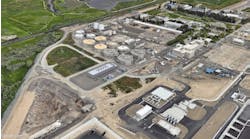Credit: Hinode JAXA/NASA
The following is an excerpt from new our report, The Energy Efficient Microgrid.
It can be difficult for microgrids to compete on cost alone if they provide only electricity. However, when combined heat and power (CHP) is added to the equation, microgrids become more competitive based on economics alone.
Why? Most power generation technologies involve production of heat. CHP recaptures this heat for productive uses.
As discussed in our report, The Energy Efficient Microgrid: What Combined Heat & Power and District Energy Bring to the Microgrid Revolution, CHP reuses waste heat to:
- Provide heating and domestic hot water services and eliminate the need for boilers and associated equipment within a building
- Produce chilled water for air conditioning and eliminate the need for customers to install, maintain and repair chillers, cooling towers and associated equipment
- Reduce fuel costs and consumption, since the same fuel that produces the electricity produces the heat
“By harvesting and using the heat produced when making electricity, you are establishing a much more bankable, financeable and economically attractive asset,” said Robert Thornton, president and CEO of the International District Energy Association.
A CHP district energy microgrid can optimize the production of electricity, power and cooling as needed to meet the heating, cooling and power loads of the connected buildings. With advanced controls and forecasting technologies, the system can operate more efficiently as loads vary seasonally and daily. Very cold and very hot days put strain on the grid as consumers increase use of air conditioners or electric heating systems. Electricity prices skyrocket. Further, grid operators often must turn on their last-choice, highest polluting generators when demand runs high. CHP/DE microgrids can help mitigate the strain by shifting their heating and cooling loads off the grid and instead using their on-site resources. This reduces cost and reduces emissions.
Sometimes during severely cold periods, fuel supplies deplete. The US Northeast has run short on natural gas because of pipeline constraints during recent winters. At times the electric system has teetered close to outages because of the shortages. With demand great and supply low in winter 2013/14, fuel prices spiked, which translated into hikes as high as 38 percent in consumer generation costs in 2014. (Hartford Courant, December 17, 2013).
Other areas in North America have experienced shortages in coal during recent winters because trains lacked room to take deliveries, as oil and other commodities competed for space. Propane for home heating also was in short supply in winter 2013/14 for a variety of reasons, including competition for the fuels used for other purposes.
CHP district energy systems often operate on multiple fuels and can switch primary fuel supply depending on cost and availability. These fuel shortages underscore why it is important to have more CHP/DE microgrids, with their highly efficient use of fuel, integrated into the North American grid.
“When you locate the generating source closer to the load, you can reduce congestion, enhance reliability and lower the total cost of delivering that electricity. When the asset also provides integrated heating and cooling services, you can change the demand and load shape on the grid. As a result, you have a more resilient, reliable grid because you have reduced strain and taken some of the load off the wires,” Thornton said.
The Energy Efficient Microgrid: What Combined Heat & Power and District Energy Bring to the Microgrid Revolution is provided as a free download, courtesy of Solar Turbines and the International District Energy Association.







